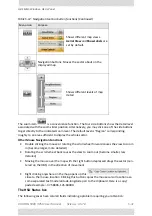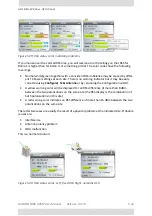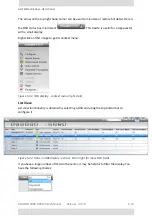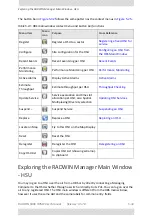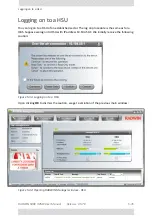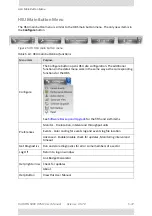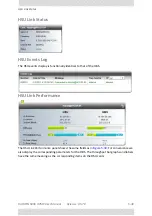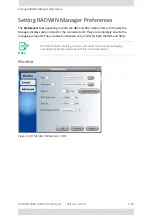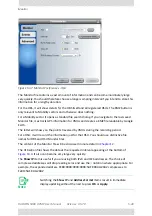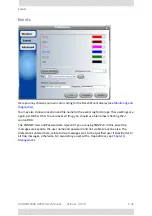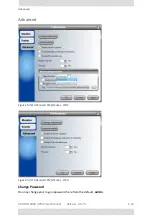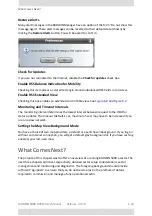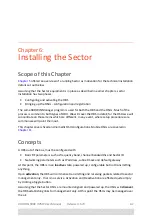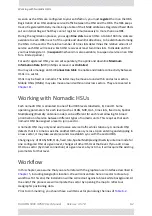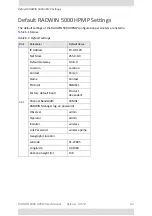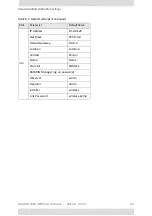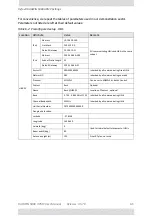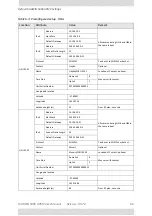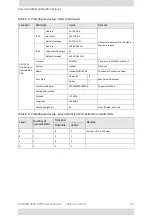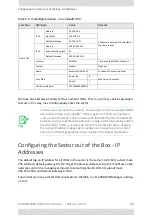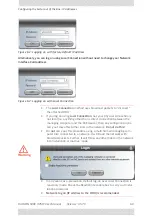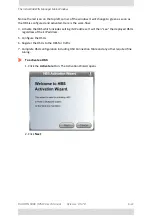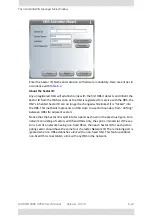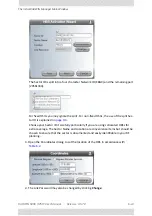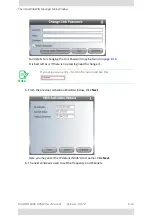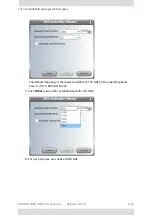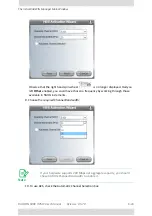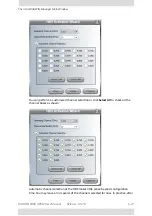
RADWIN
5000
HPMP
User
Manual
Release
3.5.70
6
‐
2
Working
with
Nomadic
HSUs
As
soon
as
the
HSUs
are
configured
to
your
satisfaction,
you
must
register
them
on
the
HBS.
Registration
of
an
HSU
enables
service
traffic
between
the
HSU
and
the
HBS.
The
HBS
keeps
track
of
registered
HSUs
by
maintaining
a
table
of
their
MAC
addresses.
Registered
fixed
HSUs
set
an
internal
flag
so
that
they
cannot
register
simultaneously
to
more
than
one
HBS.
During
the
registration
process,
you
assign
time
slots
to
each
HSU.
A
total
of
63
time
slots
are
available
to
each
HBS
in
each
of
the
uplink
and
downlink
directions,
to
be
distributed
among
the
HSUs
in
the
sector.
The
relative
number
of
time
slots
determines
the
relative
amount
of
service
each
HSU
will
receive.
Each
HSU
receives
at
least
two
time
slots.
To
disable
an
HSU
you
must
deregister
it.
(A
suspend
mechanism
is
also
available,
to
suspend
service
on
an
HSU
for
a
limited
period.)
For
each
registered
HSU,
you
can
set
separately,
the
uplink
and
downlink
Maximum
Information
Rate
(MIR)
in
Mbps
or
leave
it
as
Unlimited
.
You
may
also
manage
an
HSU
Connection
table
to
enable
and
disable
connectivity
between
HSUs
in
a
sector.
HSUs
may
be
fixed
or
nomadic.
The
latter
may
be
move
around
within
and
across
sectors.
Mobile
HSUs
(HMUs)
may
also
move
around
within
and
across
sectors.
They
are
covered
in
.
Working
with
Nomadic
HSUs
Each
nomadic
HSU
is
allocated
to
one
of
four
HBS
levels
labelled
A,
B,
C
and
D.
Some
operating
parameters
for
each
level
(such
as
VLAN,
MIR,
QoS,
time
slots,
fixed
rate,
Spatial
Multiplexing/Diversity
antenna
mode)
can
be
different
for
each
level
allowing
for
broad
prioritization
of
service
between
different
types
of
nomadic
units.
This
requires
that
each
nomadic
HSU
be
assigned
a
level
to
join
a
sector.
A
nomadic
HSU
may
only
send
and
receive
service
traffic
while
stationary.
A
nomadic
HSU
detects
that
it
is
time
to
seek
the
another
HBS
upon
sync
loss.
Upon
entering
and
stopping
in
a
new
sector,
it
may
take
several
seconds
to
establish
sync
with
the
sector
HBS.
Changing
any
of
VLAN,
MIR,
QoS,
fixed
rate,
Spatial
Multiplexing/Diversity
antenna
mode
for
one
configured
HSU
at
a
given
level,
changes
all
other
HSUs
at
that
level.
If
you
add
a
new
HSU
to
a
sector
(by
direct
connection)
at
a
given
level,
at
sync
time,
it
will
acquire
the
existing
parameters
for
that
level.
Workflow
In
this
chapter,
we
assume
that
you
are
familiar
with
the
graphical
user
interface
described
in
,
including
Geographic
location.
We
will
concentrate
here
on
sector
radio
setup
workflow.
To
this
end,
the
installation
will
be
carried
out
against
a
blank
white
background.
At
the
end
of
the
process
we
will
complete
the
sector
by
opening
the
map
to
reflect
our
Geographic
positioning
data.
Prior
to
commencing,
you
should
have
a
written
sector
plan
along
the
lines
of
Summary of Contents for 5000 HPMP
Page 1: ...USER MANUAL RADWIN 5000 POINT TO MULTIPOINT BROADBAND WIRELESS Release 3 5 70...
Page 21: ...Part 1 Basic Installation Release 3 5 70...
Page 69: ...Part 2 Sector Installation Release 3 5 70...
Page 155: ...Part 3 Sector Management Release 3 5 70...
Page 197: ...RADWIN 5000 HPMP User Manual Release 3 5 70 8 42 Nomadic...
Page 252: ...RADWIN 5000 HPMP User Manual Release 3 5 70 11 8 Registering HMUs 3 Open the Air Interface tab...
Page 290: ...Part 4 Site Synchronization Release 3 5 70...
Page 319: ...RADWIN 5000 HPMP User Manual Release 3 5 70 16 7 Configuring the GSU...
Page 320: ...Part 5 Advanced Installation Topics Release 3 5 70...
Page 354: ...Part 6 Field Installation Topics Release 3 5 70...
Page 396: ...Part 7 Product Reference Release 3 5 70...
Page 517: ......

